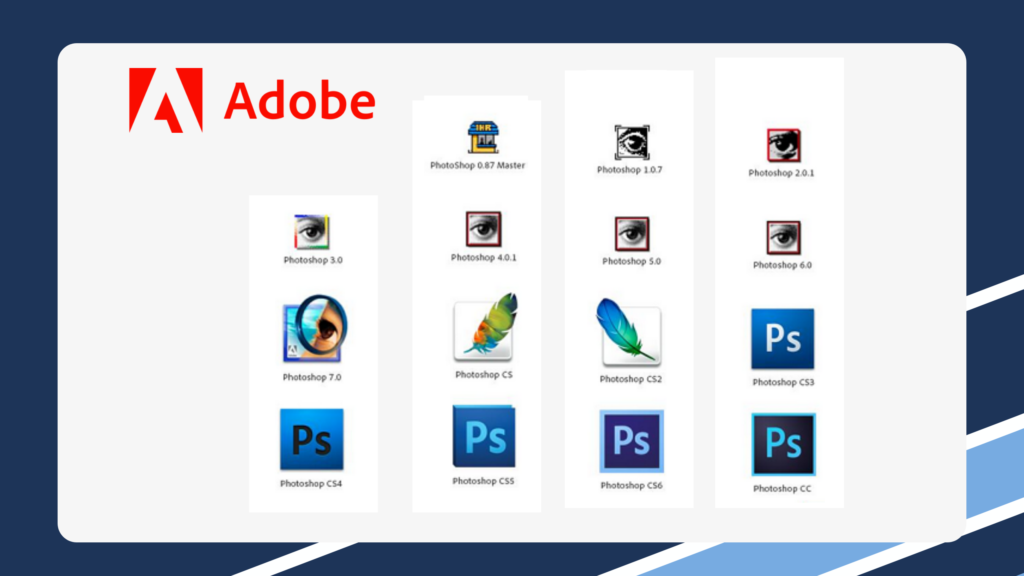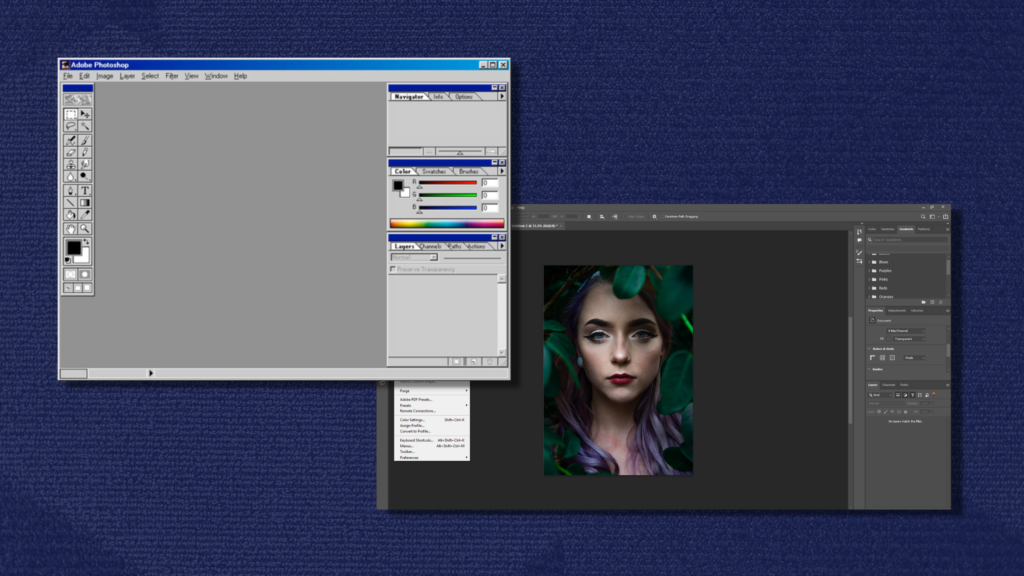You don’t have to be an artist or be creatively inclined in any way, shape, or form to recognize the name Photoshop. Nowadays, we see that any picture manipulated or changed in any way is called by the layman as ‘Photoshopped’ no matter the software used. This is proof that the history of Photoshop managed to affect the graphic design community in a substantial way.

Heck this software has managed to make itself a verb. I am not kidding, it’s listed in the Merriam-Webster Dictionary as a transitive verb and defined as follows:
“to alter (a digital image) with Photoshop software or other image-editing software especially in a way that distorts reality (as for deliberately deceptive purposes)”

This is because this software is one of the oldest digital art software out there. It is a household name and to this very day remains unbeatable as the most popular and recognized software. In this article we are going to take a deep dive into the history of Photoshop to learn about this legendary software a bit more.
When Photoshop was invented?
Sometime in 1987, in a University of Michigan dark dorm room, there was a PhD student with his ol’ trusty Mackintosh Plus who was writing a program he called ‘Display’. That very PhD student, Thomas Knoll, with a nudge of encouragement from his brother, John Knoll, ended up giving this world the most legendary digital art software.

At this stage of the software’s life, Thomas wanted to make a software that would be able to display, hence its name at the time ‘Display’, grayscale images on a monochrome monitor. Real cool name Tommy, no one could have thought of THAT!
At that time, while Thomas was a PhD student, John (his brother, if you’ve forgotten already) worked at a company called Industrial Light & Magic, this company was a division of the one and only film and TV company Lucas film.
This company created visual effects for movies and such. John, being in the field of graphics, was interested in what his brother had concocted. He encouraged his brother to go through with this project and make it a full fledged image manipulation software.
Thomas was reluctant at first, arguing that making a commercial product would be a difficult thing to do, however his brother convinced him he would somehow figure out a way to make money with it.
Thomas took the advice of his brother and took a break from college to focus entirely on his software making process. Wow Thomas really trusted his brother huh. Anyways, the name choosing process for Photoshop was an arduous one as it appears.
In an excerpt from an article in PhotoshopNews.com we find an interesting bit:
“Thomas changed the name of their software several times. Each time he found one he liked, it had already been taken. ImagePro, and even PhotoHut were considered.
Then, during a program demo, he confided to someone that he was having problems naming the program. The confidant suggested PhotoShop, and that became the program’s working name…”
We are now in 1989 and the duo had a solid name for their software that wasn’t used before. Now they had to commence their “sponsoring”. T
he first way Photoshop was sold was an interesting one. The duo made a deal, a short time one, with a company called Barneyscan. They had agreed to have the software be included in a bundle of the company’s slide scanner, which is a scanner made to scan 35mm slides and film negatives, and , of course, the software. This deal garnered Photoshop 200 sales, which isn’t that bad, is it?
History of Photoshop versions

After the brother’s deal with BarneyScan came to an end, the brothers had to take their venture a step further, and that marked a milestone in the history of Photoshop. John headed to Silicon Valley and pitched the software to Apple.
Everyone was a fan of the software, so much so that they asked John to leave them some copies. Apparently, this was the first time Photoshop was pirated as the people at Apple at the time shared the software with a lot of people and did not hold back.
Adobe was next on John’s hunting list. He pitched the software to the art director of the company, Russel Brown, and although Photoshop had major competition with another software named ColorStudio, Photoshop successfully swept Russel off of his feet, that’s why you hear the software called Adobe Photoshop.
The brothers successfully sold the license to distribute the software to Adobe in 1988. The reason why we say Adobe purchased ‘the license to distribute the software is that Adobe didn’t really own Photoshop, they could sell it, but for each copy sold they had to pay the Knoll brothers. This was really smart of the Knoll brothers, especially after the Software’s further boom in popularity.
Not long after, though, Adobe did buy the software for a whopping 34.5 million dollars, this way Adobe didn’t pay any kind of royalty to the Knoll brothers, but they sure got their pockets filled. Darn it, I wish my brother convinced me to take a break from college and make a software in 1987.

Finally in 1990 Photoshop 1.0 was released into the wild and cost about $895. Yeah, safe to say that Photoshop was never cheap, was it? At that stage, Photoshop was a Macintosh exclusive, but that would not last long as not many years passed before the software was made available in Microsoft’s Windows. Windows being much more used and having a better reach overall, as it was all the rage, helped the software bloom in popularity.
After this point, the rest is history. It’s so interesting to see this software go into a sort of ‘birth’, and then peaking and solidifying itself in the digital arts world. Makes you wonder if there are any further steps for the software.
History of Adobe with Photoshop’s Evolution

Today, Photoshop is a household name that still thrives, its latest release was this February 2022, Version 23.3.
You have to admire a software that started with a 1.0 release and is now at it’s 23rd release. It’s like seeing a baby grow into a full-grown adult with a car, house, and a wife. The thing’s got a verb to its name. No seriously, this software is so old, it’s got a whole family now.
Adobe has worked on a whole suite, Adobe’s illustrator, InDesign, Premiere pro… and many more that would all be in Adobe’s Creative Suite and would include Photoshop, of course. We even talked about After Effect’s history if that’s something of interest to you.
It’s safe to say that Photoshop is now the industry’s standard. We witness a lot of artists migrating from their open-source, free or even affordable softwares to use Photoshop when they start becoming professional artists, photographers, or any kind of creative, really.
However, on the fateful July 17, 2013, Adobe announced a new plan. Their Creative Suite, which was a one time purchase of all the software Adobe had developed, would become a brand new business model by the name “Creative Cloud”.
CC would provide all of their Photoshop Family software and more for a monthly expensive subscription, instead of permanent ownership as has been the case up to that point.
The backlash after this was huge. Creatives from all around the world vehemently opposed it and scrambled to find an alternative. This makes us wonder, has this been able to shake the Photoshop/Adobe throne that’s been held strong for years?
Jessibelle Garcia writes in an article for MUO about this very topic:
“Adobe is the industry standard because it’s been at the top for a long time. It got and stayed there by continuously innovating. While all the other competitors on the market are playing copycat, Adobe is laser-focused on ensuring its products remain professional, innovative, and easy-to-use. That said, CC has a hefty price tag because Adobe is well-aware that competition is slim to none.”

And that’s the general sentiment. Since Adobe and Photoshop are one inseparable duo, much like the Knoll brothers, with the popularity of Adobe, its major influence on the industry and the financial backing, it might be safe to say that Photoshop is staying with us for a long time in the future.
And not only that but leading the way as well, Photoshop feels like an anchor in the industry in a way. The industry was built around it, so whoever has to come replace it, if the day ever comes, has to be as or more legendary.
Conclusion

Now that we have taken a deep dive into the world of Photoshop, we understand the history of this great software and can not help but gawk at its success. From code lines in a clunky Macintosh Plus machine, to one of the biggest and most defining pillars of the digital art industry, that was Photoshop.






























